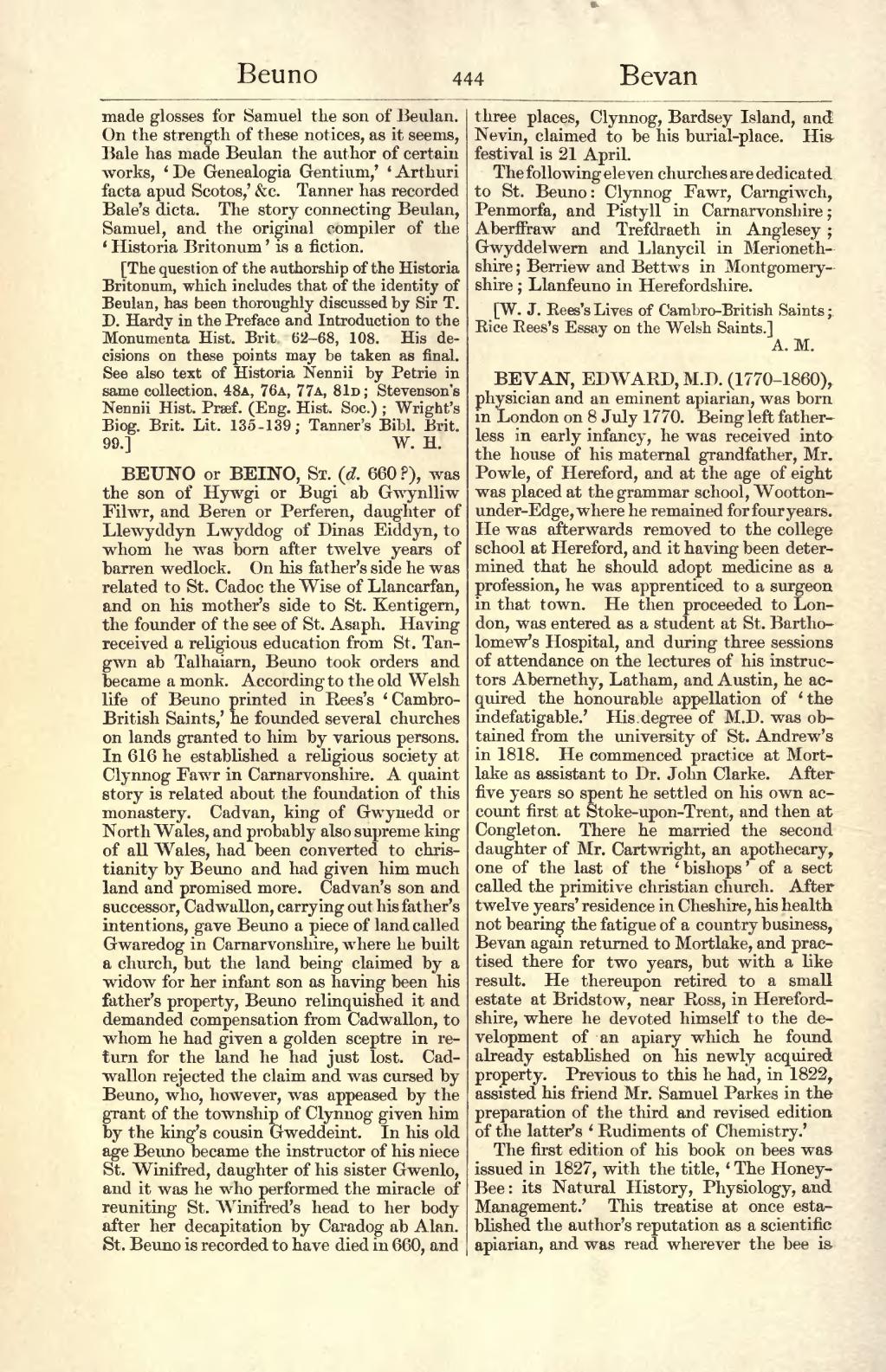made glosses for Samuel the son of Beulan. On the strength of these notices, as it seems, Bale has made Beulan the author of certain works, 'De Genealogia Gentium,' 'Arthuri facta apud Scotos,' &c. Tanner has recorded Bale's dicta. The story connecting Beulan, Samuel, and the critical compiler of the 'Historia Britonum' is a fiction.
[The question of the authorship of the Historia Britonum, which includes that of the identity of Beulan, has been thoroughly discussed by Sir T. D. Hardy in the Preface and Introduction to the Monumenta Hist. Brit. 62–68, 108. His decisions on these points may be taken as final. See also text of Historia Nennii by Petrie in same collection, 48a, 76a, 77a, 81d; Stevenson's Nennii Hist. Præf. (Eng. Hist. Soc.); Wright's Biog. Brit. Lit. 135–139; Tanner's Bibl. Brit. 99.]
BEUNO or BEINO, St. (d. 660?), was the son of Hywgi or Bugi ab Gwynlliw Filwr, and Beren or Perferen, daughter of Llewyddyn Lwyddog of Dinas Eiddyn, to whom he was born after twelve years of barren wedlock. On his father's side he was related to St. Cadoc the Wise of Llancarfan, and on his mother's side to St. Kentigem, the founder of the see of St. Asaph. Having received a religious education from St. Tangwn ab Talhaiarn, Beuno took orders and became a monk. According to the old Welsh life of Beuno printed in Rees's 'Cambro-British Saints,' he founded several churches on lands granted to him by various persons. In 616 he established a religious society at Clynnog Fawr in Carnarvonshire. A quaint story is related about the foundation of this monastery. Cadvan, king of Gwynedd or North Wales, and probably also supreme king of all Wales, had been converted to Christianity by Beuno and had given him much land and promised more. Cadvan's son and successor, Cadwallon, carrying out his father's intentions, gave Beuno a piece of land called Gwaredog in Carnarvonshire, where he built a church, but the land being claimed by a widow for her infant son as having been his father's property, Beuno relinquished it and demanded compensation from Cadwallon, to whom he had given a golden sceptre in return for the land he had just lost. Cadwallon rejected the claim and was cursed by Beuno, who, however, was appeased by the grant of the township of Clynnog given him by the king's cousin Gweddeint. In his old age Beuno became the instructor of his niece St. Winifred, daughter of his sister Gwenlo, and it was he who performed the miracle of reuniting St. Winifred's head to her body after her decapitation by Caradog ab Alan. St. Beuno is recorded to have died in 600, and three places, Clynnog, Bardsey Island, and Nevin, claimed to be his burial-place. His festival is 21 April.
The following eleven churches are dedicated to St. Beuno: Clynnog Fawr, Carngiwch, Penmorfa, and Pistyll in Carnarvonshire; Aberffraw and Trefdraeth in Anglesey; Gwyddelwern and Llanycil in Merionethshire; Berriew and Bettws in Montgomeryshire; Llanfeuno in Herefordshire.
[W. J. Rees's Lives of Cambro-British Saints; Rice Rees's Essay on the Welsh Saints.]
BEVAN, EDWARD, M.D. (1770–1860), physician and an eminent apiarian, was born in London on 8 July 1770. Being left fatherless in early infancy, he was received into the house of his maternal grandfather, Mr. Powle, of Hereford, and at the age of eight was placed at the grammar school, Wootton-under-Edge, where he remained for four years. He was afterwards removed to the college school at Hereford, and it having been determined that he should adopt medicine as a profession, he was apprenticed to a surgeon in that town. He then proceeded to London, was entered as a student at St. Bartholomew's Hospital, and during three sessions of attendance on the lectures of his instructors Abernethy, Latham, and Austin, he acquired the honourable appellation of ‘the indefatigable.’ His degree of M.D. was obtained from the university of St. Andrew's in 1818. He commenced practice at Mortlake as assistant to Dr. John Clarke. After five years so spent he settled on his own account first at Stoke-upon-Trent, and then at Congleton. There he married the second daughter of Mr. Cartwright, an apothecary, one of the last of the ‘bishops’ of a sect called the primitive christian church. After twelve years' residence in Cheshire, his health not bearing the fatigue of a country business, Bevan again returned to Mortlake, and practised there for two years, but with a like result. He thereupon retired to a small estate at Bridstow, near Ross, in Herefordshire, where he devoted himself to the development of an apiary which he found already established on his newly acquired property. Previous to this he had, in 1822, assisted his friend Mr. Samuel Parkes in the preparation of the third and revised edition of the latter's ‘Rudiments of Chemistry.’
The first edition of his book on bees was issued in 1827, with the title, ‘The Honey-Bee: its Natural History, Physiology, and Management.’ This treatise at once established the author's reputation as a scientific apiarian, and was read wherever the bee is
